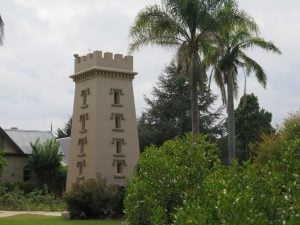The Seahorse Inn Hotel at Boydtown
14 March 2016
Not too early a start today, just taking it easy exploring around the area of Eden. Not far away we turned off to Quarantine Bay, a pretty spot, just freshened up after an early shower of rain, and a popular fishing spot (below).
We headed further south and found Boydtown, which is now a very luxurious boutique hotel, The Seahorse Inn, which doesn’t seem to be widely advertised – maybe they like to keep it a secret! The water frontage is Twofold Bay and the whole area is quite delightful.
The area of Ben Boyd National Park is named after Benjamin Boyd, a Scottish entrepreneur who proposed to base his Steamship Company at Twofold Bay. Boyd’s paddle-steamers operated between Sydney, Twofold Bay and Hobart. Boyd purchased a large section of land in the southern portion of the Twofold Bay where he established the townships of Boydtown, which at its peak had 200 inhabitants and East Boyd where he established a whaling station.
The first building erected in Boydtown was the “Seahorse Inn”, named after one of Boyd’s steam-boats. The foundations were constructed of sandstone imported from Sydney and the rest of the building from locally made bricks and hardwood and with cedar and oak fixtures imported from England. The hotel was built with convict labour and never fully finished. Boyd also built a row of houses, which he christened ” Jerusalem,” for the use of the workmen he employed.
Financial mismanagement and the overly ambitious nature of his schemes led to him being declared bankrupt and in 1848 he departed Australia in the Wanderer to try to recoup his fortunes in the Californian goldfields where he again met with disappointment. After his failure in the goldfields he set sail again, this time to cruise the Pacific. In 1851 he disappeared at Guadalcanal in the Solomon Islands when he went ashore to hunt ducks. Despite searches initiated by his creditors his body was never recovered. You can read more about Benjamin Boyd here
We set off to find Boyd’s Tower further toward the coast, but when we arrived at the turnoff we were prevented from going further by a fireman as they were undertaking fire control burns. So instead we made our way close by to the Naval Wharf (below right), very high secured, but we were able to see the gigantic wharf and parts of the chip mill (below left) further around Twofold Bay.
Green Cape Lighthouse was next on the agenda, and we knew it was 23kms off the main road, but did not realise how bad the road was – for my Toyota Yaris, which is a very spoilt car, it was a bit of a shock to its system! By the time we reached the Cape the wind was howling (as it usually is around light houses) and was a rather gloomy sight. It also has a gloomy history due to the number of shipwrecks in the 1800s where many lives were lost. I could only imagine how terrifying it must have been for ships’ passengers to be swept on to the treacherous rocks around the Cape.
Built in 1883 and perched on the edge of a peninsula, Green Cape Lightstation is the tallest and most southerly in NSW. Its octagonal tower juts out from a square base, in dramatic contrast to the low-lying landscape surrounding it. It looks across Disaster Bay, the site of many shipwrecks.
On the way back to the highway we pulled off the road to the lookout over Disaster Bay. The lookout is the perfect spot to enjoy birdwatching and nature photography while taking in the unspoilt coastline of the NSW Far South Coast region. It’s a perfect stop on a driving tour, taking in the coastal delights of Ben Boyd National Park. Looking out to sea, you soak in the amazing views and natural beauty of Disaster Bay and the Pacific Ocean. Behind you, the magnificent Nadgee-Howe Wilderness Area runs all the way to the Victorian border. It brought back memories of a wonderful holiday we spent at Nadgee Nature Reserve in late 1980, staying with the Head Ranger and family and being able to explore this beautiful Reserve.
From the lookout you might see migrating whales from late May to early December, with the best sightings around September through November. Bring your binoculars and keep your eyes peeled for local seabirds such as the Australasian gannet, oystercatchers and the white-bellied sea eagle.
Disaster Bay from the lookout, Nadgee Nature Reserve at the southern end of the bay
Arriving back in Eden we visited the Killer Whale Museum and learned the story of Old Tom, the killer whale who, with his “pack” of relative whales, helped to herd whales for the whaler families in Eden – a fascinating story of the relationship between the whales and the whalers. You can read about Old Tom here
The Killer Whale Museum (above) a Mako shark (below left) and the skeleton of Old Tom (below right)
We tried to find a restaurant that was open on a Sunday evening, and started at Snug Cove where there were three or four cafes and restaurants, but unfortunately Eden goes to bed early on Sunday, so we found ourselves at the Great Southern Inn for a tasty meal (see the Tastes page here
Part of the fishing fleet in Snug Cove (right)
Tomorrow we leave Eden, and New South Wales, for a night stopover at Bemm River, Victoria.















